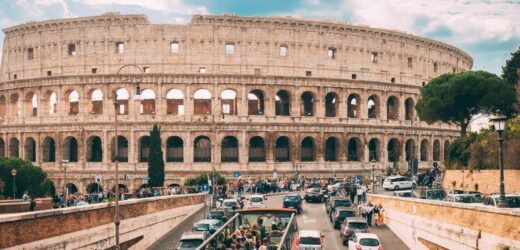For our free coronavirus pandemic coverage, learn more here.
Rome: Italy significantly ramped up pressure on its unvaccinated population, announcing that a digital or printed health pass would be necessary for accessing a range of everyday leisure activities, from theatres to indoor dining.
The decision announced on Thursday puts Italy in a rare category along with France among Western nations that have been willing to leverage certain freedoms and equalities now that vaccines have become widely available.
Italy is essentially betting that it can revive its slowing vaccination campaign – and avoid future, onerous restrictions – by creating heavy incentives for inoculation, in the kind of step that would be politically unthinkable in the United States.
Tourist souvenirs sit displayed for sale near a cafe selling pizza and sandwiches in Rome, Italy.Credit:GIULIO NAPOLITANO
Though technically the pass can be obtained with proof of antibodies or from a recent negative coronavirus test, those paths are far less straightforward than getting vaccinated. And in an evening news conference, Italian Prime Minister Mario Draghi made clear that his goal was to encourage vaccinations, which have flagged over the last month.
“I invite all Italians to get vaccinated and do it immediately,” Draghi said. Avoiding vaccination, he said, “is an appeal to die.”
The decision comes as the more transmissible delta variant spreads across Europe, triggering early warning signs in country after country about an oncoming wave.
In Italy, after nearly two consecutive weeks with fewer than 1000 daily cases, numbers are rising again; Thursday, the government announced more than 5000 cases. That level is far removed from the horrors of winter and spring, and with 46 per cent of the population vaccinated, many in the country are widely protected from severe sickness and hospitalisation. But it is the rest of the population that is causing concern.
Italian PM Mario Draghi has announced new requirements for Italians wanting to participate in public events.Credit:AP
The concern is also economic, as Italy is looking for ways to avoid a new round of closures and curfews. For now, every Italian region is “white” – meaning that life proceeds almost as normal, and people can stay out as late as they want. That has made for a joyful Italian summer, punctuated by a European Championship final victory that triggered through-the-night partying.
But already, scientists are wondering whether there will be a repeat of 2020, when people dropped their guard in the summer as the virus receded, only to see it come racing back.
As part of its announcement on Thursday, Italy laid out new guidelines for when regions might be hit with tightened restrictions, basing the determination around hospitalisation levels, rather than the spread of positive cases.
“We want to avoid a growth in contagions bringing new general closures,” Roberto Speranza, the health minister, said. “The instrument we have is that of vaccinations.”
Previously, Italy had mandated use of what is known as its Green Pass only sparingly, for entrance to nursing homes, for instance, or for travel outside Italy. But the expanded mandatory use, which takes effect August 6, will apply to sporting events, indoor dining, fairs, conferences, spas and casinos.
Earlier this month, French President Emmanuel Macron announced a similar set of measures, though slightly more forceful, because the health pass was also required for forms of public transit. Vaccination appointments surged in the aftermath. But hundreds of thousands also took to the streets in protest.
In Italy, the decision to more widely use the Green Pass has been contentious.
The leader of the far-right League, Matteo Salvini, said in an Italian newspaper interview several days ago that the pass should be used for stadiums, “but not for a pizza.”
Salvini, who is part of Draghi’s wide-ranging coalition, noted Thursday on Twitter that Italy’s hospital situation was “under control, and he said “freedom” was a guiding principle. There are 158 coronavirus patients in intensive care in Italy, compared with roughly 4000 at the height of previous waves.
Washington Post
Most Viewed in World
From our partners
Source: Read Full Article




